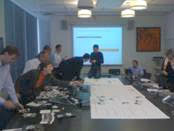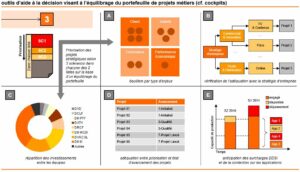« Portfolio management is the art and science of selecting and overseeing a group of investments that meet the long-term financial objectives and risk tolerance of a client, a company, or an institution »
Everything started with a pain point, each business departement had a lot of good ideas and projects to improve its business and each production factory has a lot of good ideas and transformation programs to improve its urbanism and applications. But there is not enough room for everybody, everything can’t be done and even less so in the expected deadlines.
That’s why the Enterprise IT organization created a new job, « Business Partner« , to manage projects portfolio and coordinate business and production teams. It was just a title, what to do and how to do it was then to be defined.
This was the first spark…
First mission, Business IT Steerco for Enterprise (BISE)

My first mission was to help the « Business Partner » understand and define his/hers and,
design a method and a governance to reach his/her goals.
The transformation programs were built by the Enterprise IT departments
to respond to all business projects.
We have set up a monthly Business/IT Steerco bringing together all the business and IT departments to:
- Identify and share the objectives of different business departments (23 ambitions grouped into 7 axes of business transformations)
- so that each business department understands the challenges of the other departments
- to determine the MVP, deadlines and expected gains
- Make IS transformation projects clearly understood (41 enablers out of 15 IS bricks) and to make the the business departments appropriate them
- Prioritize and schedule transformation projects to meet business priorities according to
- Business priority and deadline
- KPI, Expected gains
- Complexity factor
- Semi-annual budgets
#wink: I developed a PHP tool to visualize the real-time impacts of priorisation over roadmap and budget
Second mission, CLINT (Comité de Légitimation des Investissements Nationaux en Telecom)
 Thanks to the BISE method sucess,
Thanks to the BISE method sucess,
this second mission was the improvement and generalization of the first one,
adding the mass market businesses and IT scopes.
After a first « crash program » to quickly set a shared roadmap for the following semester, the method shall now:
- integrating all business, IS, process and network departments
- involving top and middle management
- take charge of OPEX (OPEX decisions / CAPEX impact)
- connect to the tools:
- automation of project/application mapping
- automatic integration of consumed and « Rmains to be done »
- milestones follow-up
- define the new organization, its governance (France Governance Committee) and the associated change management
At the end, the technical and IS department had become the owner and organizer of the business and technical roadmap.
Third mission, give back to the business management the control on its Roadmap
 The management of business priorities could not remain the prerogative of IS and technical management.
The management of business priorities could not remain the prerogative of IS and technical management.
My third mission consisted of supporting the program management and the mass market marketing management
in their approach to reclaiming the method.
La démarche devait:
- be part of a business project management industrialization program (definition of methods, milestones, deliverables, etc.)
- integrate into business and technical transformation programs governances
- provide methodological advice
- alignment of Marketing and Channel plans with Orange France strategic plan
- method of scripting and arbitration of the roadmap
- organization and animation of workshops and prioritization seminar
- provide support to the project team, in the animation of project qualification workshops
- continuation of the qualification process for marketing and channel projects
- continuation of the IS impact qualification process in relation to the work of the crash program and the France governance committees
- build a project repository
- maintenance of a consolidated repository of all projects for the general public
- implementation of tools for facilitating and managing project qualification workshops
- organize around a dedicated team (5 people)
- industrialize around a real-time tool for managing the assets of the approach (programs, projects, budgets, milestones, …), reporting